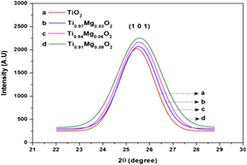Crossref Citations
This article has been cited by the following publications. This list is generated based on data provided by
Crossref.
Li, Yuxin
Fu, Rong
Wang, Xiangdong
and
Guo, Xiaoling
2018.
Preparation of core–shell nanostructured black nano-TiO2 by sol–gel method combined with Mg reduction.
Journal of Materials Research,
Vol. 33,
Issue. 24,
p.
4173.
Yu, Chengtao
Zhang, Jingyi
Yang, Hexu
Zhang, Ling
and
Gao, Yu
2019.
Enhanced photovoltaic conversion efficiency of a dye-sensitized solar cell based on TiO2 nanoparticle/nanorod array composites.
Journal of Materials Research,
Vol. 34,
Issue. 07,
p.
1155.
Li, Changxin
Liu, Yan
Zhang, Yanzong
Long, Lulu
Shen, Fei
Yang, Gang
Zhang, Xiaohong
He, Yan
Wang, Lilin
and
Deng, Shihuai
2019.
Electro-assisted ammonium persulfate activation to promote the introduction of N and S into TiO2 film: Enhancing its photoelectrocatalytic performance under solar.
Journal of Materials Research,
Vol. 34,
Issue. 20,
p.
3573.
Wei, Liguo
Wu, Qinhang
Yang, Yongsheng
Jiang, Bo
Sun, Gonglei
Feng, Jing
Yu, Furong
Kang, Yu
and
Dong, Guohua
2020.
One-step synthesis of nitrogen-decorated CeO2/reduced graphene oxide nanocomposite and its electrocatalytic activity for triiodide/iodide reduction.
Journal of Materials Research,
Vol. 35,
Issue. 11,
p.
1461.
Heiba, Zein K.
Mohamed, Mohamed Bakr
and
Ahmed, Sameh. I.
2021.
Optical and electronic correlation in Mg-doped nano cadmium sulfide.
Optical and Quantum Electronics,
Vol. 53,
Issue. 5,
Luo, Jin-Hua
Mo, Yun-Fei
Li, Ze-Sheng
and
Du, Fu-You
2021.
Doping effects on catechol functionalized anatase TiO2(101) surface for dye-sensitized solar cells.
Materials Research Express,
Vol. 8,
Issue. 1,
p.
015906.
Lv, Chunmei
Wang, Xiuwen
Li, Qun
Li, Chunyan
Ouyang, Qiuyun
Liu, Yongjun
and
Qi, Lihong
2021.
Template-assisted synthesis of porous TiO2 photoanode for efficient dye-sensitized solar cells.
Journal of Materials Research,
Vol. 36,
Issue. 3,
p.
688.
Giordani, Thainá
Dose, Janaine
Kuskoski, Yassmin
Schultz, Juliana
Mangrich, Antonio Salvio
de Mello, Josiane Maria Muneron
Silva, Luciano Luiz
Zeferino, Rubieli Carla Frezza
Zanetti, Micheli
Fiori, Márcio Antônio
and
Colpani, Gustavo Lopes
2021.
Photocatalytic degradation of propranolol hydrochloride using Nd–TiO2 nanoparticles under UV and visible light.
Journal of Materials Research,
Vol. 36,
Issue. 7,
p.
1584.
Fan, Xiaojuan
2022.
Flexible dye-sensitized solar cells assisted with lead-free perovskite halide.
Journal of Materials Research,
Vol. 37,
Issue. 4,
p.
866.
Dlamini, Menelisi C.
Dlamini, Mbongiseni L.
Mente, Pumza
Tlhaole, Boitumelo
Erasmus, Rudolph
Maubane-Nkadimeng, Manoko S.
and
Moma, John A.
2022.
Photocatalytic abatement of phenol on amorphous TiO2-BiOBr-bentonite heterostructures under visible light irradiation.
Journal of Industrial and Engineering Chemistry,
Vol. 111,
Issue. ,
p.
419.
Nithya, P.
Roumana, C.
Velraj, G.
Balasubramanian, V.
Shkir, Mohd.
and
Reddy, Vasudeva Reddy Minnam
2022.
Biomass-derived carbon (BC) modified CoWO4 nanoparticles composites for improved performance of dye-sensitized solar cells.
Chemical Physics Letters,
Vol. 803,
Issue. ,
p.
139814.
Danladi, Eli
Ichoja, Andrew
Onoja, Emmanuel D.
Adepehin, Damilare S.
Onwoke, Elijah E.
Ekwu, Ohi M.
and
Alfred, Daniel O.
2023.
Broad-band-enhanced and minimal hysteresis perovskite solar cells with interfacial coating of biogenic plasmonic light trapping silver nanoparticles.
Materials Research Innovations,
Vol. 27,
Issue. 7,
p.
521.
Barcelos, Daniel Alves
and
Gonçalves, Maria Clara
2023.
Daylight Photoactive TiO2 Sol-Gel Nanoparticles: Sustainable Environmental Contribution.
Materials,
Vol. 16,
Issue. 7,
p.
2731.
Rajaramanan, Tharmakularasa
Velauthapillai, Dhayalan
Ravirajan, Punniamoorthy
and
Senthilnanthanan, Meena
2023.
A facile impregnation synthesis of Ni-doped TiO2 nanomaterials for dye-sensitized solar cells.
Journal of Materials Science: Materials in Electronics,
Vol. 34,
Issue. 10,
Adedokun, O.
Sivaprakash, P.
Ajani, A.S.
Bello, I.T.
and
Arumugam, S.
2023.
Structural, optical and magnetic studies of sol-gel synthesized Mg-doped pure anatase TiO2 nanoparticles for spintronic and optoelectronics applications.
Physica B: Condensed Matter,
Vol. 667,
Issue. ,
p.
415199.
Erdogar, Kubra
Yucel, Ozgun
and
Oruc, Muhammed Enes
2023.
Investigation of Structural, Morphological, and Optical Properties of Novel Electrospun Mg-Doped TiO2 Nanofibers as an Electron Transport Material for Perovskite Solar Cells.
Nanomaterials,
Vol. 13,
Issue. 15,
p.
2255.
Markose, Aparna
Das, Debanita
and
Ravindran, Prasanth
2023.
Quantitative framework development for understanding the relationship between doping and photoelectrochemical energy conversion of TiO2.
Materials Advances,
Vol. 4,
Issue. 16,
p.
3399.
Tasiu, Jamila
Onimisi, Muhammad Y.
Yusuf, Abubakar S.
Danladi, Eli
and
Tasie, Nicholas N.
2024.
Effect of Biosynthesized Silver Nanoparticles on The Optical, Structural, and Morphological Properties of TiO2 Nanocrystals.
East European Journal of Physics,
p.
315.
Bala, Dennis A.
Ali, Haruna
Onimisi, Muhammad Y.
and
Danladi, Eli
2024.
Effect of MgO recombination barrier layer on the performance of monolithic-structured solid-state dye sensitized solar cells.
Materials Research Innovations,
Vol. 28,
Issue. 2,
p.
71.




